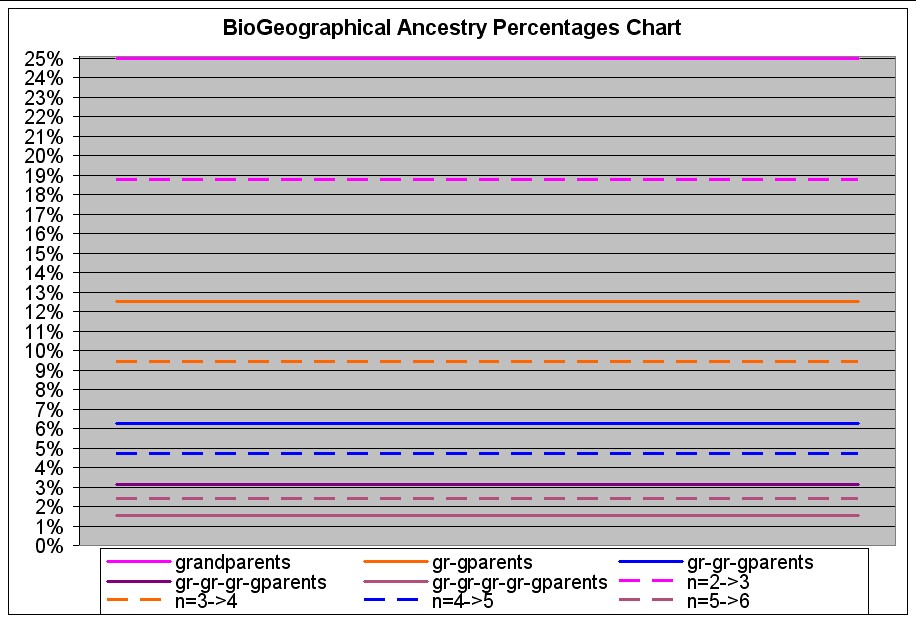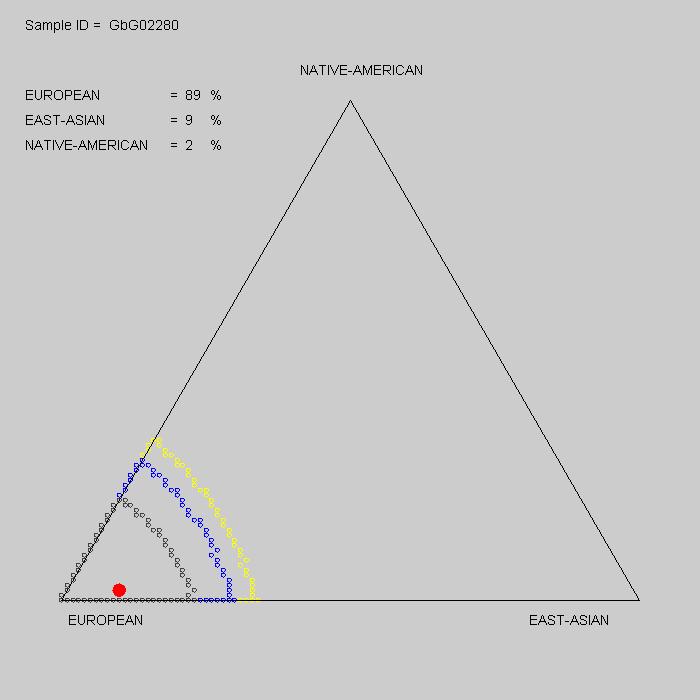- (n=1): Suppose one has one parent that is 100% BGA #1 and one that is 100% BGA #2: Then he/she is 50% BGA1 and 50% BGA2. (One side of his/her two chromosome strands is BGA1 and the other side is BGA2. In the process of producing progeny the two strands of the chromosome will equally mix up so that each strand of the chromosome is 50% BGA1 and 50% BGA2.)
- (n=2): Suppose one has three grandparents that are 100% BGA1 and one that is 100% BGA2: Then he/she is 75% BGA1 and 25% BGA2. (One side of his/her two chromosome strands is BGA1 and the other side is 50% BGA1 and 50% BGA2. In the process of producing progeny he/she will equally mix up the two strands of the chromosome, so that there are various possible combinations of BGA1 and BGA2 genes in each strand of a chromosome, with the most probable combination being 25% BGA2 in one strand and 25% BGA2 in the other strand. This introduces some uncertainty in the amount of BGA2 his/her progeny will have, but the uncertainty is very small for the approximately 60,000 human genes.)
- (n=3): Suppose one has seven great-grandparents that are 100% BGA1 and one great-grandparent that is 100% BGA2: Then he/she is 87.5% BGA1 and 12.5% BGA2 to a high degree of certainty, but he/she could have smaller than 12.5% BGA2.
- (n=4): Suppose one has fifteen great-great-grandparents that are 100% BGA1 and one that is 100% BGA2: Then he/she is 93.75%% BGA1 and 6.25% BGA2.
- (n=5): Suppose one has thirty-one great-great-great-grandparents that are 100% BGA1 and one that is 100% BGA2: Then he/she is 96.875% BGA1 and 3.125% BGA2.
- (n=6): Suppose one has sixty-three great-great-great-great-grandparents that are 100% BGA1 and one that is 100% BGA2: Then he/she is 98.4375% BGA1 and 1.5625% BGA2.
The analysis above assumes that the BGA2 comes from only one nearest 100%-BGA2 ancestor; it could come from more than one 100%-BGA2 nearest ancestor. In that case the ancestors would be further back in time than the analysis above indicates.
Since the errors on the BGA results are usually of the order of ±2.5% [e.g., for my result given below, my East-Asian value is (17±2.5)%], one cannot determine fractional ancestry with BGA back further than great-great-great-grandparents or back no further than 5 generations.For my case of (17±2.5)% East Asian, BGA indicates that my 100%-East-Asian ancestor was a great-grandparent; it could be that there are two (or more) 100%-East Asian ancestors, one great-grandparent and one great-great-grandparent (12.5% + 6.25%=18.75%) or three great-great-grandparents (3 x 6.25%=18.75%).
For the case of my wife of (9±2.5)% East Asian and (2±2.5)% Native American, her East-Asian ancestor was a great-great-grandparent (or a great-great-grandparent and a great-great-great-grandparent [6.25% + 3.125%=9.375%]) and her Native-American ancestor was either a great-great-great-grandparent, a great-great-great-great-grandparent, or did not exist. (The 2.5% error could mean that the result of 2% could easily be 0%.)

This is a chart one can use to decide in which generation an ancestor is according to the percentage of ancestry given by the BioGeographical Ancestry test. For example, my (17±2.5)% East-Asian component lies closest to the great-grandparents' percentage and my wife's (9±2.5)% East-Asian component lies closest to the great-great-grandparents' percentage. Her (2±2.5)% Native-American component could be either gr-gr-gr-grandparents or gr-gr-gr-gr-grandparents or further back or none at all.
Case #1 in these studies clearly shows the effects of recombination (gene mixing) upon reproduction: The three siblings have different admixtures of Indo-European, Native-American and sub-Saharan-African ancestry and each one also has different admixtures than the parents have.
| Ancestry | Estimate | ||||||||||||||||||||||||||||||||||||||||||||||||||||||||||||||||||||||||||||||||||||||||||||||||||||||||||||||||||||||||||||||||||||||||||||||||||||||||||
| Indo-European | 83% | ||||||||||||||||||||||||||||||||||||||||||||||||||||||||||||||||||||||||||||||||||||||||||||||||||||||||||||||||||||||||||||||||||||||||||||||||||||||||||
| East-Asian | 17% | ||||||||||||||||||||||||||||||||||||||||||||||||||||||||||||||||||||||||||||||||||||||||||||||||||||||||||||||||||||||||||||||||||||||||||||||||||||||||||
| Native-American | 0% | ||||||||||||||||||||||||||||||||||||||||||||||||||||||||||||||||||||||||||||||||||||||||||||||||||||||||||||||||||||||||||||||||||||||||||||||||||||||||||
 The first contour (black line) around your BGA result delimits the space outside of which the points are 2 times less likely, and the second contour (blue line) delimits the space outside of which the estimates are 5 times less likely. The third contour (yellow line) delimits the space outside of which the estimates are 10 times less likely than your result. |
|||||||||||||||||||||||||||||||||||||||||||||||||||||||||||||||||||||||||||||||||||||||||||||||||||||||||||||||||||||||||||||||||||||||||||||||||||||||||||
| Comments of L. David Roper about these results:
This was quite a surprise to me. I expected some Native-American admixture
because of the legends of such for my great-great-great grandmother Roper;
apparently those legends are incorrect. I have no idea where the East-Asian
admixture came into my ancestry; it would have to be further back than
grandparents. Note that the confidence intervals lean toward the Native-American side of the triangle. It may be that my East-Asian admixture is the small minority of Native Americans that have the X mtDNA haplotype. Perhaps the NE Asians migrated both ways, some into North America and some toward Europe. My percentage results are the same as Brett Strobel's. |
|||||||||||||||||||||||||||||||||||||||||||||||||||||||||||||||||||||||||||||||||||||||||||||||||||||||||||||||||||||||||||||||||||||||||||||||||||||||||||
A Genotype is the actual building block at one
location on your DNA. For instance if, at a certain location, you inherited an
'A' from your mother and a 'C' from your father, your genotype would be 'AC'
for that location. (The DNAPrint results do not distinguish paternal-maternal
order; i.e., it could be AC or CA.) There are approximately 3,000,000,000
building blocks (base pairs) in the human genome, however only 0.1% of these
building blocks are variable from person to person. The BGA test measures the
specific genotype at 70 highly informative deep ancestral locations. Genotypes
for L. David Roper:
|
|||||||||||||||||||||||||||||||||||||||||||||||||||||||||||||||||||||||||||||||||||||||||||||||||||||||||||||||||||||||||||||||||||||||||||||||||||||||||||
| Go back to top | |||||||||||||||||||||||||||||||||||||||||||||||||||||||||||||||||||||||||||||||||||||||||||||||||||||||||||||||||||||||||||||||||||||||||||||||||||||||||||
| Ancestry | Estimate | ||||||||||||||||||||||||||||||||||||||||||||||||||||||||||||||||||||||||||||||||||||||||||||||||||||||||||||||||||||||||||||||||||||||||||||||||||||||||||
| Indo-European | 89% | ||||||||||||||||||||||||||||||||||||||||||||||||||||||||||||||||||||||||||||||||||||||||||||||||||||||||||||||||||||||||||||||||||||||||||||||||||||||||||
| East-Asian | 9% | ||||||||||||||||||||||||||||||||||||||||||||||||||||||||||||||||||||||||||||||||||||||||||||||||||||||||||||||||||||||||||||||||||||||||||||||||||||||||||
| Native-American | 2% | ||||||||||||||||||||||||||||||||||||||||||||||||||||||||||||||||||||||||||||||||||||||||||||||||||||||||||||||||||||||||||||||||||||||||||||||||||||||||||
 The first contour (black line) around your BGA result delimits the space outside of which the points are 2 times less likely, and the second contour (blue line) delimits the space outside of which the estimates are 5 times less likely. The third contour (yellow line) delimits the space outside of which the estimates are 10 times less likely than your result. |
|||||||||||||||||||||||||||||||||||||||||||||||||||||||||||||||||||||||||||||||||||||||||||||||||||||||||||||||||||||||||||||||||||||||||||||||||||||||||||
| The 2% for Native-American is well
within the measurment errors. If it is true, the responsible ancestor would
have to be further back than great-great-great grandparents if it came from one
single person in a pair. The 9% East-Asian would have to be further back than
great-grandparents if it came from one single person in a pair. Note that the confidence intervals lean as much toward the Native-American side of the triangle as toward the East-Asian side. This implies that the 2% Native-American is real. |
|||||||||||||||||||||||||||||||||||||||||||||||||||||||||||||||||||||||||||||||||||||||||||||||||||||||||||||||||||||||||||||||||||||||||||||||||||||||||||
A Genotype is the actual building
block at one location on your DNA. For instance if, at a certain location, you
inherited an 'A' from your mother and a 'C' from your father, your genotype
would be 'AC' for that location. There are approximately 3,000,000,000 building
blocks (base pairs) in the human genome, however only 0.1% of these building
blocks are variable from person to person. The BGA test measures the specific
genotype at 70 highly informative deep ancestral locations. Genotypes for
Jeanne Muriel Baril Roper:
|
|||||||||||||||||||||||||||||||||||||||||||||||||||||||||||||||||||||||||||||||||||||||||||||||||||||||||||||||||||||||||||||||||||||||||||||||||||||||||||
There are approximately 60,000 genes in humans. The number of ancestors, if all are unique, for which at least one gene for each are still now in one's DNA are given by the equation:
[# of ancestors in the nth generation] = 2n= 60000, the solution is about n=16. Of course, often an early ancestor is an ancestor more than once. In fact, mitochondrial Eve and Y-chromosome Adam are probably thousands of times an ancestor of all living humans. I have done some rough calculations about how the number of identical ancestors in a given generation might vary as one goes back into previous generations. From those calculations I would guess that the "ancestry limit" is about 20 generations or about 400-500 years ago. Half of the ancestors in the generation back from that "ancestry limit" generation cannot supply any genes to the current generation.